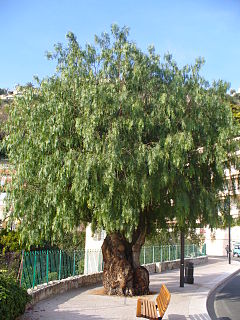| Schinus | |
|---|---|

| |
| Schinus terebinthifolia | |
| Scientific classification | |
| Kingdom: | Plantae |
| Clade: | Tracheophytes |
| Clade: | Angiosperms |
| Clade: | Eudicots |
| Clade: | Rosids |
| Order: | Sapindales |
| Family: | Anacardiaceae |
| Subfamily: | Anacardioideae |
| Genus: | Schinus L. (1753)[1][2] |
| Type species | |
| Schinus molle | |
| Species | |
|
See text | |
| Synonyms[4] | |
| |

Schinus is a genus of flowering trees and tall shrubs in the sumac family, Anacardiaceae. Members of the genus are commonly known as pepper trees. The Peruvian pepper tree (Schinus molle)[5] is the source of the spice known as pink peppercorn.[6]
The species of Schinus are native to South America, ranging from Peru and northeastern Brazil to southern South America.[4] Some species (e.g. Schinus terebinthifolia) have become an invasive species outside their natural habitats. Schinus polygama, although less well known, is also potentially weedy in mesic areas.
Etymology
[edit]The generic name is derived from the Greek word for Pistacia lentiscus, Σχίνος (schinos), which it resembles.[7] Considerable historic confusion has existed as to the correct gender of the genus name; as of 2015, this has been resolved with the determination that the correct gender of Schinus is feminine (rather than masculine), and adjectival names within the genus must be spelled accordingly.[8]
Species
[edit]34 species are currently accepted:[4]
- Schinus areira L. – Peru, Bolivia, northern Chile
- Schinus bumelioides I.M.Johnst. – northern Argentina
- Schinus engleri F.A.Barkley – Argentina, Brazil, and Uruguay
- Schinus fasciculata (Griseb.) I.M.Johnst. – Bolivia, Paraguay, and northern Argentina
- Schinus ferox Hassl. – southern Brazil, Paraguay, Uruguay, northern Argentina (Misiones Province)
- Schinus gracilipes I.M.Johnst. – northwestern Argentina
- Schinus johnstonii F.A.Barkley – Argentina and Uruguay
- Schinus kauselii F.A.Barkley – central Chile
- Schinus latifolia (Gillies ex Lindl.) Engl. – central Chile
- Schinus lentiscifolia Marchand – southern Brazil, Paraguay, Uruguay, northern Argentina (Misiones Province)
- Schinus longifolia (Lindl.) Speg. – west-central and southern Brazil, Paraguay, Uruguay, nand northern Argentina
- Schinus marchandii F.A.Barkley – southern Chile and southern Argentina
- Schinus meyeri F.A.Barkley – Bolivia and northwestern Argentina (Salta Province)
- Schinus microphylla I.M.Johnst. – Peru and Bolivia
- Schinus molle L. Peruvian pepper tree
- Schinus molle var. molle (=S. bituminosa, S. occidentalis) – Peru and northern Chile; southern Brazil, Paraguay, Uruguay, and northeastern Argentina
- Schinus molle var. rusbyi (L.) DC. – southern Peru and northern Chile
- Schinus montana Engl. – central Chile
- Schinus myrtifolia (Griseb.) Cabrera – Bolivia and northwestern Argentina
- Schinus odonellii F.A.Barkley – southern Chile and western Argentina
- Schinus pampeana Bordignon & Vog.Ely – southern Brazil (Rio Grande do Sul)
- Schinus patagonica (Phil.) I.M.Johnst. ex Cabrera – central and southern Chile and western Argentina
- Schinus pearcei Engler – Bolivia, northern Chile, and Peru
- Schinus pilifera I.M.Johnst. – Bolivia and northern Argentina
- Schinus polygama (Cav.) Cabrera (=S. dentata, S. dependens) – Chile and northwestern Argentina (Mendoza)
- Schinus praecox (Griseb.) Speg. – north-central Argentina
- Schinus ramboi F.A.Barkley – southern and southeastern Brazil
- Schinus roigii Ruíz Leal & Cabrera – western Argentina
- Schinus sinuata (Griseb.) Engl. – northeastern Argentina
- Schinus spinosa Engl. – Brazil (Paraná state)
- Schinus talampaya Fabbroni & M.A.Zapater – northwestern Argentina (San Juan and La Rioja)
- Schinus terebinthifolia Raddi Brazilian pepper tree – northeastern to southeastern Brazil, northeastern Argentina, and Paraguay
- Schinus terebinthifolia var. acutifolia Engl.
- Schinus terebinthifolia var. terebinthifolia (=S. aroiera, S. chichita, S. mellisii, S, mucronulata, S. rhoifolia)
- Schinus uruguayensis (F.A.Barkley) Silva-Luz – southern Brazil, Uruguay, and northeastern Argentina
- Schinus velutina (Turcz.) I.M.Johnst. – central Chile
- Schinus venturii F.A.Barkley – southern Bolivia to northwestern Argentina (Salta)
- Schinus weinmanniifolia Mart. ex Engl.[9] – south-central to eastern and southern Brazil, Paraguay, Uruguay, and northeastern Argentina
Formerly placed here
[edit]- Cuscuta myricoides (L.) Druce (as S. myricoides L.)
- Limonia acidissima L. (as S. limonia L.)
- Lithraea molleoides (Vell.) Engl. (as S. molleoides Vell.)
- Zanthoxylum fagara (L.) Sarg. (as S. fagara L.)[9]
References
[edit]- ^ "Genus: Schinus L." Germplasm Resources Information Network. United States Department of Agriculture. 2009-11-23. Retrieved 2011-02-22.
- ^ Linnaeus, C. (1753), Species Plantarum 1: 388
- ^ "Schinus L." TROPICOS. Missouri Botanical Garden. Retrieved 2010-02-09.
- ^ a b c Schinus L. Plants of the World Online. Retrieved 23 April 2023.
- ^ Seidemann, Johannes (2005). World spice plants. Springer. p. 337. ISBN 978-3-540-22279-8.
- ^ Allen, Gary (2007). The Herbalist in the Kitchen. University of Illinois Press. pp. 26–27. ISBN 978-0-252-03162-5.
- ^ Quattrocchi, Umberto (2000). CRC World Dictionary of Plant Names: Common Names, Scientific Names, Eponyms, Synonyms, and Etymology. Vol. IV R-Z. Taylor & Francis US. p. 2405. ISBN 978-0-8493-2678-3.
- ^ Zona, S. (2015). The correct gender of Schinus (Anacardiaceae). Phytotaxa, 222(1), 75–77. doi:https://doi.org/10.11646/phytotaxa.222.1.9
- ^ a b "GRIN Species Records of Schinus". Germplasm Resources Information Network. United States Department of Agriculture. Retrieved 2015-07-22.
External links
[edit] Media related to Schinus at Wikimedia Commons
Media related to Schinus at Wikimedia Commons
Well, that’s interesting to know that Psilotum nudum are known as whisk ferns. Psilotum nudum is the commoner species of the two. While the P. flaccidum is a rare species and is found in the tropical islands. Both the species are usually epiphytic in habit and grow upon tree ferns. These species may also be terrestrial and grow in humus or in the crevices of the rocks.
View the detailed Guide of Psilotum nudum: Detailed Study Of Psilotum Nudum (Whisk Fern), Classification, Anatomy, Reproduction